 © CC BY-SA 3.0
© CC BY-SA 3.0Harry Partch
American composer born 24 June 1901 in Oakland, California; died 3 September 1974 in San Diego.
Do you notice a mistake?
Survey of works by Harry Partch
The compositional work of Harry Partch is inseparable from his lifelong work in music theory and instrument building; the constant, constructive interaction between these three fields of activity is essential to the development of his creative career. In the 1930s, Partch’s desire to restore speech to the center of musical practice led him to develop both a tuning theory encompassing extremely fine gradations of pitch and the first instruments (the Adapted Viola and Adapted Guitar) capable of realizing his vision in sound. His theories shaped the notation and pitch organization of all his later works, and also guided the further development of his instrumentarium, as reflected in the physical design of keyboards and strings. As Partch became a virtuoso performer on his own instruments, their physical layout and idiomatic potential began to play a role in the composing process, affecting in their turn the gestures of the music itself. Despite the intense energy devoted to the creation of new theories and instruments, Partch was careful to emphasize that they were a means to an artistic end: “I am essentially not an instrument builder, but a composer. I am a philosophic music man, who long ago was seduced into musical carpentry.”
Theory
Partch’s theories advocate the revival of 'pure' or 'just' intonation: the tuning of musical intervals to the smoothest, most acoustically perfect consonances. Just intonation was viewed as the ideal tuning system from antiquity until the sixteenth century, when the practical requirements of transposition and modulation made necessary the adoption of temperament: the slight detuning of intervals from their optimal acoustical sizes to allow greater flexibility in moving between keys and to limit the number of keys required on fixed-pitch instruments like the harpsichord and organ. By the time Partch began his composing career in the early twentieth century, just intonation seemed likely to become merely a historical footnote, with the twelve-tone equal temperament of the piano a virtually unquestioned international standard.
Just intonation describes every musical interval as a ratio of two integers, which can be taken to refer either to relative string lengths (as measured by the ancient Greeks on their monochords) or to frequencies of oscillation (measured today in Hertz, or vibrations per second). The two quantities are linked by an inverse relationship: when a cellist stops his A string at the halfway point and bows the lower half, the tone produced is an octave above the open string: the stopped string vibrates at a frequency (440 Hz) twice that of the open string (220 Hz), and is half the open string’s length. The recognition of a relationship between musical consonance and whole-number ratios is credited to Pythagoras, who demonstrated that other intervals besides the octave (2/1) could also be represented by simple integer ratios, for example the fifth (3/2) and the fourth (4/3).
Partch was introduced to the language of interval ratios through Hermann von Helmholtz’s 1863 Die Lehre von den Tonempfindungen als physiologische Grundlage für die Theorie der Musik, as translated and expanded by Alexander Ellis (On the Sensations of Tone, 1875). Helmholtz (1821–1894) explained the origin of consonance and dissonance in the interaction between overtones (partials) of acoustic sounds: the traditional consonances in just intonation maximized consonance and allowed an acoustically based ranking of intervals. For Partch, Helmholtz’s rationalization of consonance and dissonance suggested the possibility of founding a musical system on the “Archean granite” of acoustics rather than the inherited compromises of standard Western tuning.
“There can be no growth in musical art with the present worn-out system of music, limited to twelve tones to the octave. For that is what the piano is—twelve black and white bars in front of musical freedom. Twelve black and white stiflers.”
Example 1 shows the diagram Partch called “the one-footed bride”, presented in his central theoretical treatise Genesis of a Music as a “chart of comparative consonances.” The diagram shows pitches of one octave of Partch’s forty-three-tone scale, using his characteristic ratio notation: each pitch within the octave is represented by a ratio showing the relationship of its frequency to the tonic (1/1). The ascending scale is to be read from bottom to top on the left side, then (changing direction) from top to bottom on the right: this symmetrical arrangement places pitches that add up to an octave, like the fourth (4/3) and the fifth (3/2), opposite one another in the diagram.
The primary intervals (intervalles primaires) of Partch’s scale use ratios combining the prime numbers up to 11 (2, 3, 5, 7, 11), which makes this in Partch’s theory an “11-limit” scale, as compared to the “5-limit” of Renaissance just intonation (using only 2, 3, and 5). Secondary intervals (intervalles secondaires) include combinations of two primes: for example, 33/32 (33 = 3 x 11) and 21/16 (21 = 3 x 7). The irregular line tracing out the shape of the “one-footed bride” indicates the relative consonance of each interval: the fourth (4/3) and fifth (3/2), for example, are both highly consonant, while complex ratios like 33/32 (a quartertone above the tonic) are dissonant. Intervals are further classified into categories of suspense, power, emotion, and approach (suspensifs, pouvoir, émotion, and approche).
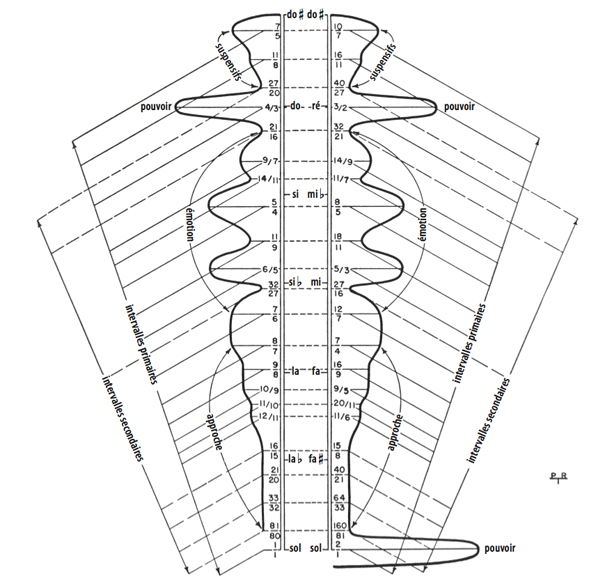
Extract from Théories de la composition musicale au XXe siècle (N. Donin and L. Feneyrou, eds., Lyon, Symétrie, 2013, p. 1483) reproduced with the kind permission of Symétrie.
While the scale of forty-three notes plays an important role in Partch’s writing, musicologist Bob Gilmore points out that Partch’s music is based not on a closed set of pitches but rather on a flexible fabric of ratio relationships that can be extended as necessary or used only in part. Many of Partch’s pieces use just a fraction of the forty-three-tone scale, while others include many more than forty-three pitches. Partch’s conception of pitch incorporates a harmonic dimension as well as a scalar one: the Tonality Diamond (shown in Example 2) organizes pitches drawn from the “one-footed bride” into overtone-series-based Otonalities (read from southwest to northeast) and their inversions, Utonalities (read from southeast to northwest). These six-note collections correspond conceptually to the major and minor triads of tonal music, and the Tonality Diamond has important conceptual links to the dualistic theories of tonality proposed by such nineteenth-century German theorists as Hugo Riemann and Arthur von Oettingen.
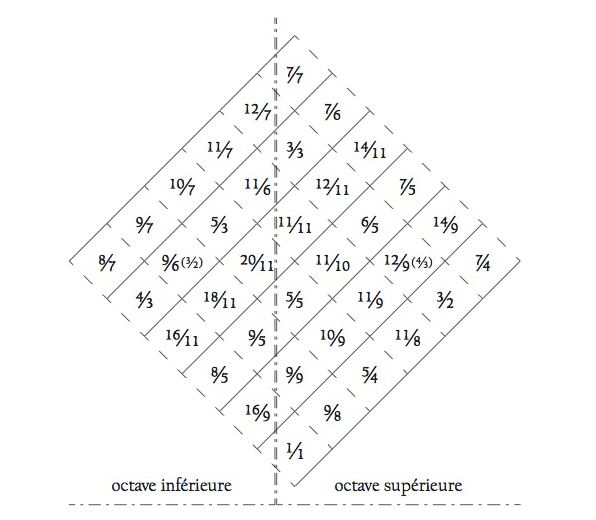
Extract from Théories de la composition musicale au XXe siècle (N. Donin and L. Feneyrou, eds., Lyon, Symétrie, 2013, p. 1483) reproduced with the kind permission of Symétrie.
Instruments
Partch’s earliest creations (in the 1930s) were string instruments (the Adapted Viola, the Adapted Guitar) with modifed fingerboards or fretboards. As his music evolved, the Partch ensemble came to incorporate reed organs, plucked strings, and (in an increasingly dominant role) percussion instruments. The instruments, now at the University of Washington in Seattle, were the subject of an extensive online documentary in 2003. Brief descriptions of the instruments follow—more extensive descriptions and a chronology of Partch’s creations are included in his Genesis of a Music.
Stringed instruments
Adapted Viola—A viola fitted with a longer cello fingerboard marked with the location of pitches in Partch’s tuning system.
Adapted Guitar (I and II)—Fretless acoustic guitars, with pitch locations indicated on the fingerboards as for the Adapted Viola.
Kithara (I and II)—Large, free-standing plucked string instruments, modeled after the Ancient Greek kithara. For certain works, Partch supplemented the Kithara with the smaller, brighter-sounding Surrogate Kithara (first designed as an “assistant” to the larger instruments for the 1952 Castor and Pollux).
Harmonic Canon (I, II, and III)—Plucked string instruments with up to eighty-eight strings, reminiscent of a zither or a plucked cimbalom; a staple (in various versions and tunings) of Partch’s ensemble beginning in the 1940s.
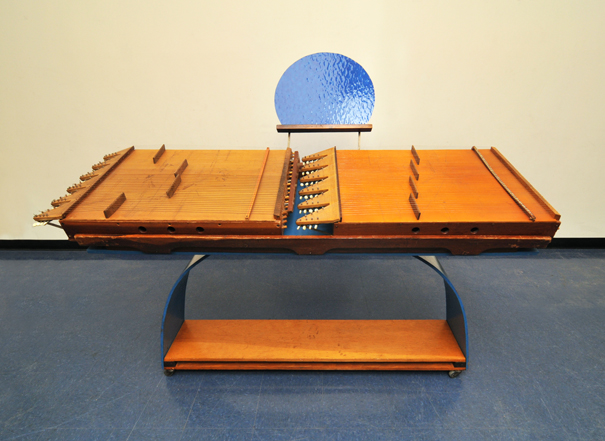
Koto—An adapted version of the Japanese instrument of the same name, with thirteen plucked strings that can be adjusted in tension during performance by applying pressure behind the bridges.
Crychord—A large, free-standing instrument with a single, variable-tension string, to be played with a wooden dowel, picks, or fingers.
Organs
Chromelodeon (I and II)—Adapted reed organs (harmoniums) with colour-coded keyboards, tuned in Partch’s extended just intonation. Partch’s first organ-type instrument, The Ptolemy (now lost), was an important precursor to the Chromelodeon, but suffered from technical problems that made it ill-suited for performance.
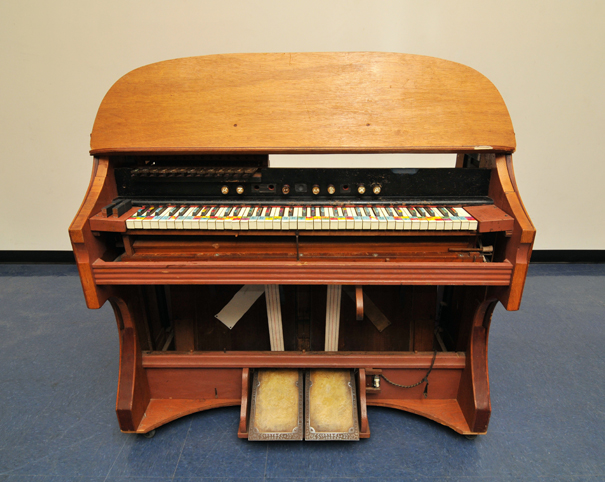
Bloboy—A bellows powering three organ pipes and an auto horn, used mainly for sound effects such as the freight train in U.S. Highball.
Percussion
Diamond Marimba—Perhaps the most visually clear manifestation of Partch’s tuning ideas, the key layout of the Diamond Marimba reflects his organization of pitches into overtone-based Otonalities and undertone-based Utonalities—these two diagonal axes determine the arrangement of the keys. Glissandi with the right hand yield arpeggiated “major” sonorities, while left-hand strokes are minor.
Quadrangularis Reversum—A compound instrument, incorporating a mirror image of the Diamond Marimba’s keyboard (thus “reversum”) as well as auxiliary keys extending the range downwards into the alto range.
Bass Marimba and Marimba Eroica—Extensions of the marimba concept to the lowest bass range, including (on the four-note Marimba Eroica) the F below the piano’s lowest key (22 Hz).
Boo (I and II)—The second major subgroup of Partch’s pitched percussion instruments, the Boo and its variants are made of bamboo sections with tuned tongues.
Eucal Blossom—A variant of the Boo, also using bamboo sections but with a brighter, dryer sound.
Mbira Bass Dyad—A simple wooden instrument providing two additional low notes for the Boo family, approximating a G (98 Hz) and A-flat (104 Hz).
Cloud-Chamber Bowls—An instrument consisting of suspended sections of Pyrex carboys, originally built from leftover glass from the University of California, Berkeley radiation laboratory, where parts such carboys were cut out to use in “cloud chambers” for the study of subatomic particles.
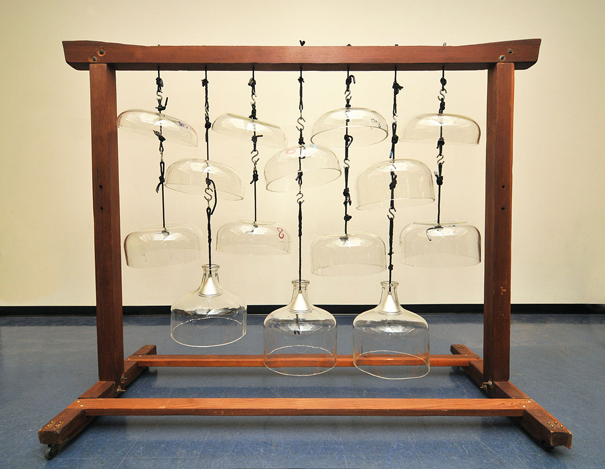
Spoils of War—A composite instrument consisting of brass artillery shell casings and a range of metallic, wooden, and glass objects.
Zymo-Xyl—A percussion instrument combining three distinct families of sounds: a wooden xylophone, a series of empty liquor bottles, and three metal objects (two hubcaps and a kettle lid).
Mazda Marimba—Twenty-four globular light bulbs, carefully tuned; amplification is required, producing “delightful sounds” resembling “the bubbling of a coffee percolator.”
Gourd Tree (with Cone Gongs)—Chinese bowl gongs bolted to gourd resonators, with accompanying “cone gongs” built from the nose cones of airplane gas tanks.
Works
Partch describes a dramatic break in his career in 1930, when he burned the manuscripts of his earlier compositions and moved with determination in the new direction suggested by his ongoing research on intonation. The first works recognized by Partch as mature are the Seventeen Lyrics by Li Po (1930–1933), a collection of intimate settings of poems by the Tang Dynasty poet in English translation. These “bardic” settings, for voice and Adapted Viola, reflect Partch’s sensitivity to the subtle inflections of speech. The pitches are notated using a combination of an approximate staff notation, a tablature for Partch’s adapted reed organ, the Chromelodeon (given for rehearsal purposes only), and an exact ratio notation for the Adapted Viola. Rhythm is left largely unnotated (except in isolated passages of vocalise), relying on the natural rhythms of the text to guide the pacing of the music.
Partch traveled in Europe in 1934–1935, funded by a research grant from the Carnegie Corporation to examine resources on tuning in the collection of the British Museum. Partch met with the poet William Butler Yeats in Dublin, discussing with him a proposed setting of Yeats’s Sophocles’ King Oedipus: A Version for the Modern Stage. Yeats was a focal figure for Partch in these years, particularly in his advocacy of a combination of words and music in which “no word shall have an intonation or an accentuation it could not have in passionate speech”—Partch’s meeting with Yeats became an important confirmation for the composer of his artistic trajectory.
On returning from Europe in 1935, Partch found himself without clear prospects of employment or any way to continue his musical researches. He describes the “dull shock of contrast in the descent” from life abroad as a traveling researcher to the harsh realities of Depression-era America. Thus began Partch’s hobo period (1935–1943), with years of life in transit alternating with stints of work, often as an itinerant dishwasher or in federal camps set up for the jobless of the Depression. Large parts of this period remain undocumented, even in Bob Gilmore’s magisterial Partch biography, as Partch criss-crossed the Western states leaving few concrete traces.
While Partch’s compositional output slowed considerably during these years, one significant document did emerge from the period of his travels: the 1935–1936 journal Partch compiled under the title Bitter Music, published posthumously in 1991. The journal includes snatches of transcribed “speech-music” interspersed with Partch’s account of life in work camps, jails, and on the road.
“I heard music in the voices all around me, and tried to notate it, and I tried to enhance the mood and drama of such little things as a quarrel in a potato patch. The nuance of inflection and thought of the lowest of our social order was a new experience in tone, and I found myself at its fountainhead—a fountainhead of pure musical Americana.”
Partch’s living situation began to become relatively settled around 1940, and he was able to return to extensive compositional work. His experience of hobo life became the focus of his works of the early 1940s, written in California, Chicago, and New York. These works, later drawn together by Partch under the title The Wayward, include Barstow—Eight Hitchhiker Inscriptions from a Highway Railing at Barstow, California (1941), U.S. Highball—A Musical Account of a Transcontinental Hobo Trip (1943), San Francisco—A Setting of the Cries of Two Newsboys on a Foggy Night in the Twenties (1943), and The Letter—A Depression Message from a Hobo Friend (1943). These works turned from the delicate poetry of the Li Po settings to the rough, slangy language of the contemporary United States, capturing both the sincere longings and arch humour of men on the road.
U.S. Highball, in a three-movement “hobo allegro” form, recounts Partch’s own trip from California to Chicago, with a pause at Little America, Wyoming described in an “adagio dishwashing movement.” The first version of U.S. Highball was for voice and Adapted Guitar only, notated entirely in Partch’s ratio notation, with each pitch indicated by its relationship to a central pitch. Later versions of the score added more instruments and refined the notation, using a different, tablature-like notation for each instrument. The companion piece to U.S. Highball, Barstow, collects and sets hitchhiker inscriptions at a roadside shelter near the desert town of Barstow, California. These texts—alternately earnest, banal, and ironic—are lovingly detailed in their rhythmic and melodic setting, often shifting from intoned speech to playful, sing-song passages. Like U.S. Highball, the original version was scored for just voice and Adapted Guitar, but in the later versions an instrumental quartet provides lively ritornello-like interludes between the texts as well as playing an accompanying role.
Starting in 1942, Partch composed mainly in various locations on the East Coast. Proximity to New York City allowed increased contact with mainstream musical figures such as Virgil Thomson, Otto Luening and Howard Hanson, and he began to receive new recognition for his work, including a prestigious Guggenheim Fellowship (1943). A number of his hobo-themed works were performed in April 1944 in Carnegie Chamber Music Hall in a concert organized by the League of Composers. These connections with musical and academic institutions led in 1944 to a three-year research residency at the University of Wisconsin, the first of a number of associations with universities (Mills College, University of Illinois) that played an important role in the performance of Partch’s larger works.
The research grant from the University of Wisconsin allowed Partch to complete the first edition of his theoretical treatise and artistic manifesto Genesis of a Music, published by University of Wisconsin Press in 1947. Partch’s distinctive voice rings out on every page, whether he is recounting the history of intonation or describing his own theory, instruments, or works. For many composers and aficionados of Partch’s music, this volume, whether in the original or the expanded 1974 edition, is their first encounter with his musical ideas.
From the late 1940s to the end of his life, Partch lived mainly in various parts of California, with brief stints in the midwestern university towns of Urbana-Champaign and Evanston. Such collaborations with universities made possible the production of major dramatic works, starting with his long-projected setting of the Oedipus tragedy, Oedipus: A Dance-Drama, first performed at Mills College in Oakland, California in 1951.
Partch’s later career is marked by a change from the intimacy of the early works and the rough, documentary style of the “Americana” works to larger, epic theatrical spectacles. In Oedipus, a large ensemble of Partch instruments accompanies four soloists and a small chorus. The work exemplifies Partch’s desire to synthesize music, text, and dance into a “dramatic unity” comparable to the ancient Greek tragedy:
“My idea has been to present the drama expressed by language, not to obscure it either by operatic aria or symphonic instrumentation. Hence, in critical dialogue, music enters almost insidiously, as tensions enter. The words of the players continue as before, spoken, not sung, but are a harmonic part of the music. […] Tone of spoken word and tone of instrument are intended to combine in a compact emotional and dramatic expression, each providing its singular ingredient.”
Partch quickly followed Oedipus with another Greek-inspired work, Castor and Pollux—A Dance for the Twin Rhythms of Gemini (1952), intended as a lighter counterpart to the tragic drama. Partch later gathered Castor and Pollux together with two other works, Ring Around the Moon (1949–1950) and Even Wild Horses (1952), under the title Plectra and Percussion Dances.
The Bewitched—A Dance Satire, first performed at the University of Illinois in 1955, shows Partch’s increasing interest in the collision of ancient culture and the modern world. The work chronicles, in ten scenes, the “unwitching” of contemporary Americans from their self-imposed delusions by the intervention of an ancient sorceress (who “corresponds to the Greek oracle”) and her ensemble of “lost musicians.” The musicians are onstage, not hidden in an orchestra pit, and Partch’s instruments become the stage set around which the musicians and dancers move.
Among the most striking of Partch’s theatre works is Revelation in the Courthouse Park (1960), which weaves together two versions of Euripides’ The Bacchae, one in its original Greek setting and the other set in the contemporary United States. The common scenic element is the town courthouse, built (as in many American small towns) on a neoclassical model with stone columns reminiscent of an ancient Greek temple. Partch drew a parallel between the worship of Dionysus and the adulation of Hollywood stars and rock idols like Elvis Presley, as represented by the character of Dion, the “Hollywood king.” The American sections of the work include parodies of American marching band and 1950s popular music, filtered through Partch’s unique instrumental ensemble.
Partch spent the last ten years of his life (1964–1974) in southern California, setting up his studio at a number of different locations in and around Los Angeles and San Diego. Partch’s works from this period, including the instrumental And on the Seventh Day Petals Fell in Petaluma (1963–1966) and the theatrical Delusion of the Fury—A Ritual of Dream and Delusion (1965–1966), show a renewed emphasis on rhythm, particularly complex polyrhythms and asymmetrical meters. And on the Seventh Day Petals Fell in Petaluma, considered by Partch as a set of “studies in preparation for Delusion of the Fury,” represents Partch’s desire to “exploit the instrumental resources to the full.” The music is extroverted and virtuosic, showing the fruits of a lifetime of practice on the instruments and the development of a relatively stable ensemble of musicians devoted to Partch’s work. A series of one-minute duets and trios, meticulously recorded by Partch and his ensemble, are presented one by one then finally combined through multitrack recording into larger ensembles. Nearly all the duets and trios made their way into Partch’s final major work, Delusion of the Fury, a combination of a Noh-inspired Japanese drama and a farcical African folk tale: “Thus, the Greek concept of a serious play followed by a farce is encompassed in one evening of theatre.”
Though Partch was never a central figure in the international world of contemporary music, he was certainly not unknown among composers of the avant garde: both Karlheinz Stockhausen and György Ligeti, for example, paid visits to the composer in his studio. Ligeti’s visit to Partch in 1972 is most immediately evident in the inclusion of “Partch effects”—narrow microtonal intervals creating subtle beating effects—in the Double Concerto of the same year. The use of just intonation (often hybridized with conventional equal temperament) became a characteristic of many of Ligeti’s later works such as the Violin Concerto or Hamburgisches Konzert. Manfred Stahnke, a student of both Ligeti and Partch’s erstwhile apprentice Ben Johnston, was an important channel for the communication of microtonal tuning ideas from the United States to Europe.
Partch’s parallel interests in microtonal theory and instrument building seem particularly relevant in recent years, as both microtonality and custom instrument construction (often in a high-tech, electronic form that might have dismayed the technophobic Partch) play an increasing role in composition. Music by contemporary microtonal composers such as Enno Poppe and Georg Friedrich Haas shows a clear awareness of Partch’s theoretical and musical work. In North America, Partch has inspired a number of disciples and admirers, including American composers working in just intonation such as Lou Harrison, Ben Johnston, and James Tenney—and in a younger generation, figures including John Luther Adams and Kyle Gann. An active culture of performance on Partch instruments and Partch-inspired instrument building (for example, Dean Drummond’s Zoomoozophone) continues, and a full working copy of Partch’s instrumentarium was built by the ensemble musikFabrik for their 2013 production of Delusion of the Fury.
Perhaps most influential of all, however, is the example Partch provides of a radical artistic vision brought into reality through sustained effort, drawing on a combination of painstaking research, craft, and inspiration.
Sources
- Bob GILMORE, « On Harry Partch’s Seventeen Lyrics by Li Po », Perspectives of New Music, Volume 30/2, 1992, pp. 22-58.
- Robert HASEGAWA, « L’intonation juste, un renouveau esthétique et théorique », dans Théories de la composition musicale au vingtième siècle (Nicolas Donin et Laurent Feneyrou, sous la dir. de), Lyon, Symétrie, 2013, pp. 1499-1531, trad. Gilles Rico.
- Harry PARTCH, Genesis of a music : an account of a creative work, its roots and its fulfillments, 2e éd., New York, Da Capo Press, 1974 ; éd. orig., Madison, University of Wisconsin Press, 1949.
- Harry PARTCH, Bitter music, Thomas McGeary (éd.),Urbana and Chicago, University of Illinois Press, 1991.
- Harry PARTCH, Barstow: Eight Hitchhiker Inscriptions from a Highway Railing at Barstow, California (1968 Version), Richard Kassell (éd.), Madison, A-R Editions, coll. « Music of the United States of America », 9, 2000.
Do you notice a mistake?